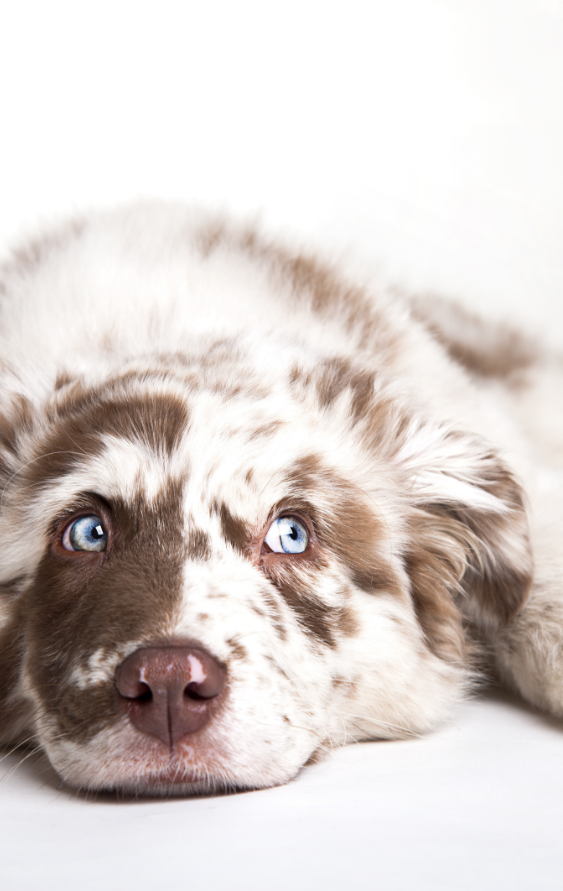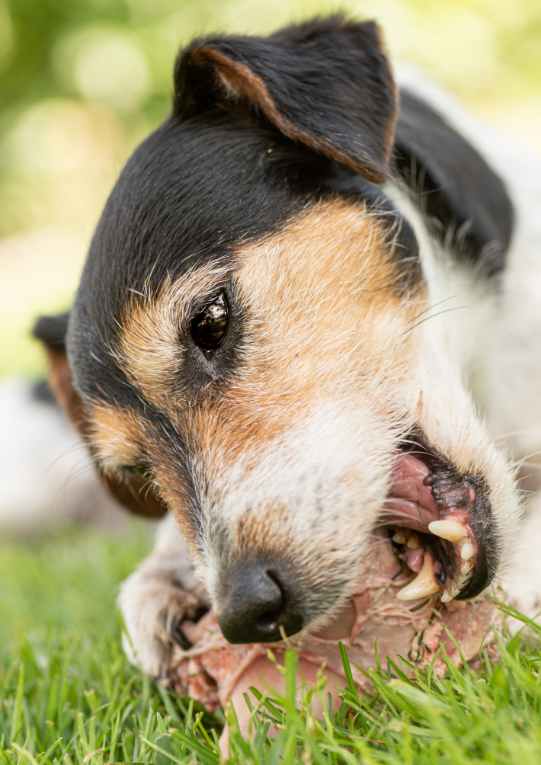THE CARNIVORE, OMNIVORE DEBATE
With so much conflicting information through various media channels, forums, raw feeding veterinary experts at the forefront of the raw feeding industry and many raw food manufactures, there’s no wonder that people are confused about what to feed their dogs. Whether dogs are carnivores or omnivores – and how to feed their dogs a raw food diet correctly, in order for them to thrive and live long healthy lives the way they should and how “NATURE” intended.
There seems to be this huge assumption at the moment that dogs are omnivores – which in-fact, still remains to be proven, however we have a plethora of very well supported evidence that shows us that dogs are carnivores.
I think a good place to start is by mentioning the fact that Dogs have been reclassified by the Smithsonian Institute and are now known as Canis lupus Familiaris (Wayne, R.K. “What is a Wolfdog?” (www.fiu.edu/~milesk/Genetics.html), (Feldhamer, G.A. 1999. Mammology: Adaptation, Diversity, and Ecology. McGraw-Hill. pg 472.). This places dogs in the same species as the Gray wolf, Canis lupus. The dog is, by all scientific standards and by evolutionary history, a domesticated wolf. Incidentally dogs and wolves share 99.8% of their mitochondrial DNA (Wayne, R.K. Molecular Evolution of the Dog Family). Mitochondria, basically, is how dogs (in this instance) absorb and process food, to turn in into energy, growth and life longevity. Dogs are so much like wolves physiologically that they are frequently used in wolf studies as a physiological model for wolf body processes. (Mech, L.D. 2003. Wolves: Behaviour, Ecology, and Conservation).
When we look at the characteristics of the carnivore vs omnivore we see clear and distinctive differences, for example, if you look into your dog’s mouth, notice those huge impressive teeth (or tiny needle sharp teeth). These are designed for grabbing, ripping, tearing, shredding, and shearing meat (Feldhamer, G.A. 1999. Mammology: Adaptation, Diversity, and Ecology. McGraw-Hill. pg 258.). Dogs unlike omnivores and herbivores do not have the large flat molars, used for grinding up plant matter. Dogs molars are pointed and are fixed in a shear bite alignment (as are all their teeth) these powerfully cut through meat, bone, and hide. Carnivores have a particular set of teeth that includes the presence of carnassial teeth: the fourth upper premolar and first lower molar, because of this dogs do not chew, they bite, rip, shred, scissor/crush and swallow.

Dogs, as well as cats, still retain their carnivorous features. They still have teeth and claws designed to catch, rip, and tear meat. Their eye position is still forward on their skull to focus on prey animals, whereas, their prey have eyes set to the sides of their skulls to watch for attacks (Schultz, 1998). The internal workings and physiology did not change in the domestication process of dogs. Although we changed their appearance and mind, we did not change their requirement for food and exercise (Baker, 2002).
Dog’s jaws are also hinged and open widely, this enables them to “gulp” large chunks of meat and bone. They are in a fixed position which prevents lateral movement of the jaw (grinding from side to side) which is necessary for eating vegetables and other plant matter. Interestingly “Dogs have the internal anatomy and physiology of a carnivore”. (Feldhamer, G.A. 1999. Mammology: Adaptation, Diversity, and Ecology. McGraw-Hill. pg 260.). It is true that over many years, humans may have indeed changed the shape, size and appearance of dogs ultimately resulting in varying breeds, but this has had no effect on their internal anatomy or physiology.
Since a dog’s internal physiology does not differ from a wolf, dogs have the same physiological and nutritional needs as those carnivorous predators, which, remember, “need to ingest all the major parts of their herbivorous prey, except the plants in the digestive system” to “grow and maintain their own bodies” (Mech, L.D. 2003. Wolves: Behaviour, Ecology, and Conservation.). In fact The book “Wolves: Behaviour, Ecology, and Conservation-2003” written by L. David Mech, who is considered to be the world’s top wolf biologist, details what he and other experts put together including over 300 years of research and observations of the wild canin. A selection from this revealing work clearly depicts the natural and instinctive eating behaviours of the carnivore. “Wolves usually tear into the body cavity of large prey and consume the larger internal organs, such as lungs, heart, and liver. The larger intestines [one of the main stomach chambers] is usually punctured during removal and the contents shaken out or spilled. The vegetation in the intestinal tract is of no interest to the wolves, but the stomach lining and intestinal wall are consumed, and their contents further strewn about the kill site.
These experts also agree that wolves will only eat the stomach contents of their prey when the prey is quite small and it gets consumed as a result of eaing the entire animal such as a rabbit for example.
To add to this “Dogs like other carnivores do NOT produce the necessary enzymes in their saliva (amylase, for example) to start the break-down process of carbohydrates and starches; amylase is produced in the saliva of omnivorous and herbivorous animals but not carnivorous animals. This places the burden entirely on the pancreas, forcing it to produce large amounts of amylase to deal with the starch, cellulose, and carbohydrates in plant matter.
The carnivore’s pancreas does not secrete cellulase to split the cellulose into glucose molecules, and neither have dogs become efficient at digesting or assimilating and utilising plant material as a source of high quality protein. Herbivores do those sorts of things” Canine and Feline Nutrition Case, Carey and Hirakawa Published by Mosby, 1995 further to this Carnivores have a highly elastic stomach designed to hold large quantities of meat, bone, organs, and hide.
Dogs have a relatively short foregut and a short, smooth, unsacculated colon. This means food passes through quickly, their digestive time is between 6-8 hours, their colon is approximately the same diameter as the small intestine which limits the ability to allow for any vegetation or grains to ferment/digest. Vegetable and plant matter, however need time to sit and ferment, meaning a longer and sacculated colon is needed, providing a digestive time of between 12-14 hours, these larger and longer small intestines, and occasionally the presence of a caecum can be found in omnivores and herbivores and although carnivores do poses a caecum it has no function. Herbivores and omnivores possess a much more developed caecum which is used as a site of bacterial fermentation of plant matter). Dogs have the shorter foregut and hindgut consistent with carnivorous animals, this is the reason why unprocessed plant matter is clearly visible in a dog’s faeces when consumed as there was no time for it to be broken down and digested. There are a number of very well educated people that are aware of this, which is why they tell you that vegetables and grains have to be pre-processed (blended or boiled) for your dog to get anything out of them, but regardless of how we attempt to manipulate digestion, the dog’s digestive system is not designed to extract enough nutrition from them to amount to enough to make it worthwhile feeding them at all, but it will tax the pancreas.

It seems as a species we humans are extremely good at taking something very simple, over thinking and complicating it, thus causing health problems. We either take the food that nature provides in a raw and balanced form with necessary enzymes, vitamins, minerals, amino acids etc, destroy them through heating and then replace them with synthetic forms, where someone with a lab coat decides which nutrients are to be replaced and in what ratio’s, or on the presumption that dogs are omnivores we feed them foods that they are evidently not equipped to eat.
At sure4pets our aim is to provide our customers and our own dogs with a complete and balanced SARF (Species Appropriate Raw Food) diet which is as close as possible to what nature intended but in a convenient manor, which as already mentioned above “carnivores” – “need to ingest all the major parts of their herbivorous prey, except the plants in the digestive system” to “grow and maintain their own bodies”. So feeding vegetables and grains to a dog (a carnivorous animal) is clearly a highly questionable practice.
Changeover
This is very easy, make the change today!! Yesterday your hard working dog was eating dried food/kibble or tinned food. Today they are eating SARF.
You need to allow your adult dog at least 24-48 hours without any solid food, by doing this you are giving their digestive system a rest, this encourages a deeper healing (always ensure they have plenty of fresh drinking water) giving them this detox time without any solid foods or treats of any kind for the full 24 hours will be the most beneficial. If you prefer, you can also split their daily food requirement into two or three smaller meals. The quality of water given during the detox and at any time is paramount as over 60% of the body is made up of water.
Please note you should never fast a puppy under the age of 12 months.
In some cases your dog may experience diarrhoea and or a small amount of vomiting, this may include undigested food, this is normal. It can take a while for the good bacteria to build up in the dogs digestive tract, especially if they have always been fed dried biscuits and or been given regular antibiotics or medication. Diarrhoea shows us that the colon is trying to quickly flush out toxins and or other irritants, remember diarrhoea is a symptom and not a disorder.
Fully grown dogs:
2% if your dog is overweight
2.5% – 3% to maintain ideal weight
5% to fatten an underweight dog
See the below table for a few examples:
(please note these figures are based on fully grown dogs)
You should feed (either in 1 or two meals) per day, if your dog weighs:
5kg 125g – 150g
10kg 250g – 300g
15kg 375g – 450g
20kg 500g – 600g
25kg 625g – 750g
30kg 750g – 900g
Remember these are guidelines and the % of food you feed is also determined by the level of exercise and activity your dog receives. You may have to adjust the amounts up or down to get the right balance but you will achieve this in no time and your pet/s will be eating the way they are born to.

